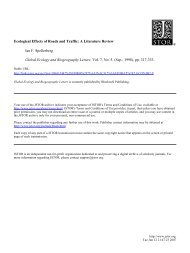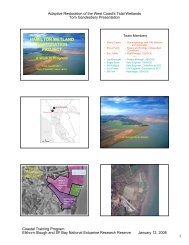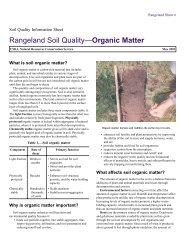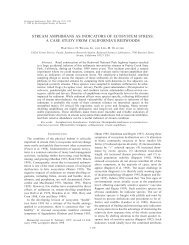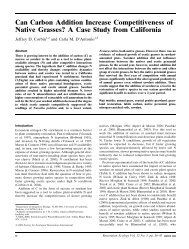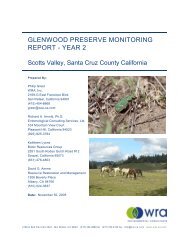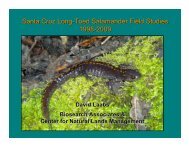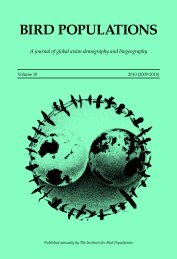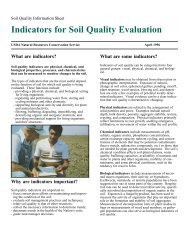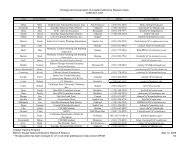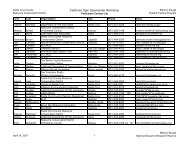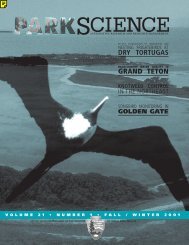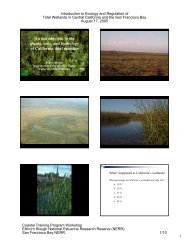Recreation and large mammal activity in an urban nature reserve
Recreation and large mammal activity in an urban nature reserve
Recreation and large mammal activity in an urban nature reserve
Create successful ePaper yourself
Turn your PDF publications into a flip-book with our unique Google optimized e-Paper software.
BIOLOGICAL CONSERVATION 133 (2006) 107– 117 113Table 3 – Relationship between wildlife relative <strong>activity</strong> (RA) <strong><strong>an</strong>d</strong> percent daytime <strong>activity</strong> (PDA) <strong><strong>an</strong>d</strong> hum<strong>an</strong> recreationalcategoriesBobcat Coyote Mule deerCoefficient r P Coefficient r P Coefficient r PRA *Overall hum<strong>an</strong> 0.023 0.33 0.021 0.193 0.29 0.047 0.007 0.04 0.775Hiker 0.038 0.34 0.016 0.371 0.34 0.017 0.012 0.05 0.756Biker 0.045 0.36 0.010 0.307 0.26 0.076 0.051 0.18 0.229Vehicles 0.039 0.11 0.433 0.555 0.17 0.250 0.008 0.01 0.947Equestri<strong>an</strong> 0.040 0.07 0.629 0.240 0.04 0.764 0.221 0.17 0.252Dog 0.028 0.07 0.633 0.318 0.08 0.578 0.128 0.14 0.352PDA **Overall hum<strong>an</strong> 0.369 0.50 0.013 0.127 0.22 0.193 0.042 0.13 0.480Hiker 0.618 0.54 0.006 0.243 0.27 0.108 0.108 0.18 0.329Biker 2.367 0.45 0.028 0.229 0.22 0.193 0.021 0.04 0.819Vehicles 0.100 0.03 0.882 0.407 0.16 0.366 0.087 0.05 0.806Equestri<strong>an</strong> 0.485 0.10 0.654 0.354 0.07 0.671 0.749 0.25 0.173Dog 1.574 0.51 0.012 1.078 0.29 0.081 0.129 0.04 0.849*All n = 49.**All n = 24 for bobcats; all n = 36 for coyotes; all n = 32 for mule deer.Table 4 – AIC results for wildlife percent daytime <strong>activity</strong> (PDA)Species Model log(Lhood) K D i AIC c W iBobcat a Log Hum<strong>an</strong> 10.168 3 0 0.642(Log Hum<strong>an</strong>) 2 8.633 3 3.070 0.138Log Hum<strong>an</strong> + (Log Hum<strong>an</strong>) 2 10.370 4 3.406 0.117Null 6.715 2 3.650 0.103Coyote a (Log Hum<strong>an</strong>) 2 9.812 3 0 0.423Null 8.067 2 0.714 0.296Log Hum<strong>an</strong> 8.979 3 1.667 0.184Log Hum<strong>an</strong> + (Log Hum<strong>an</strong>) 2 9.885 4 2.935 0.097Mule deer Null 24.958 2 0 0.614Log Hum<strong>an</strong> 25.228 3 2.347 0.190(Log Hum<strong>an</strong>) 2 25.026 3 2.750 0.155Log Hum<strong>an</strong> + (Log Hum<strong>an</strong>) 2 25.306 4 5.439 0.040Four models were exam<strong>in</strong>ed: (1) Null, <strong>in</strong> which hum<strong>an</strong>s were excluded from <strong>an</strong>alysis; (2) Log Hum<strong>an</strong>, represent<strong>in</strong>g a l<strong>in</strong>ear relationshipbetween hum<strong>an</strong> relative <strong>activity</strong> <strong>in</strong>dices <strong><strong>an</strong>d</strong> wildlife percent daytime <strong>activity</strong>; (3) (Log Hum<strong>an</strong>) 2 , which represents a non-l<strong>in</strong>ear relationshipbetween hum<strong>an</strong> <strong>in</strong>dices <strong><strong>an</strong>d</strong> wildlife percent daytime <strong>activity</strong>; <strong><strong>an</strong>d</strong> (4) Log Hum<strong>an</strong> + (Log Hum<strong>an</strong>) 2 , a non-l<strong>in</strong>ear 2nd order polynomial model.Sites with five images or more were <strong>in</strong>cluded for species PDA <strong>an</strong>alyses (see text).a St<strong><strong>an</strong>d</strong>ard normal (Z) scores.trespass<strong>in</strong>g regulations, or even sett<strong>in</strong>g aside new areas thatrestrict recreation. Alternatively, temporal displacement bydomestic dogs may suggest limit<strong>in</strong>g the hours <strong>in</strong> which a <strong>reserve</strong>is open to dog walk<strong>in</strong>g.Our f<strong>in</strong>d<strong>in</strong>gs that bobcats appeared more responsive to hum<strong><strong>an</strong>d</strong>isturb<strong>an</strong>ces th<strong>an</strong> did coyotes are consistent with priorstudies <strong>in</strong> the region. For <strong>in</strong>st<strong>an</strong>ce, Crooks (2002) exam<strong>in</strong>edthe effects of habitat fragmentation on carnivores <strong>in</strong> coastalsouthern California <strong><strong>an</strong>d</strong> concluded that bobcats were moresensitive to l<strong><strong>an</strong>d</strong>scape variables such as fragment size <strong><strong>an</strong>d</strong>isolation th<strong>an</strong> coyotes. Tigas et al. (2002) studied the responsesof radio-collared bobcats <strong><strong>an</strong>d</strong> coyotes to fragmentation<strong><strong>an</strong>d</strong> corridors <strong>in</strong> <strong>an</strong> urb<strong>an</strong> area northwest of LosAngeles <strong><strong>an</strong>d</strong> suggested that although both species partiallyadjusted to habitat fragmentation through spatial <strong><strong>an</strong>d</strong> temporalavoid<strong>an</strong>ce, coyotes tended to be relatively more toler<strong>an</strong>t ofhum<strong>an</strong> development. In the same system, Riley et al. (2003)found that some bobcats <strong>in</strong>corporated partially developedl<strong><strong>an</strong>d</strong>s <strong>in</strong>to their home r<strong>an</strong>ges, but to a lesser extent th<strong>an</strong> coyotes.Consistent with our f<strong>in</strong>d<strong>in</strong>gs, Tigas et al. (2002) <strong><strong>an</strong>d</strong> Rileyet al. (2003) also found that bobcats <strong><strong>an</strong>d</strong> coyotes tended toshift towards nocturnal use of more fragmented, developedareas; studies <strong>in</strong> other systems have also suggested that coyotes<strong>in</strong> urb<strong>an</strong> areas shift their <strong>activity</strong> to times when hum<strong>an</strong>sare less active (Andelt <strong><strong>an</strong>d</strong> Mah<strong>an</strong>, 1980; Qu<strong>in</strong>n, 1997a; Gr<strong>in</strong>der<strong><strong>an</strong>d</strong> Krausm<strong>an</strong>, 2001; McClennen et al., 2001).Research on urb<strong>an</strong> deer typically has focused on topicssuch as space use (Kilpatrick <strong><strong>an</strong>d</strong> Spohr, 2000), movementpatterns (Grund et al., 2002), hum<strong>an</strong> conflicts (McCulloughet al., 1997; Wagner et al., 1997), <strong><strong>an</strong>d</strong> responses to hunt<strong>in</strong>gpressures (Kilpatrick <strong><strong>an</strong>d</strong> Lima, 1999), but fewer studies have<strong>in</strong>vestigated possible recreational impacts on urb<strong>an</strong> deer



